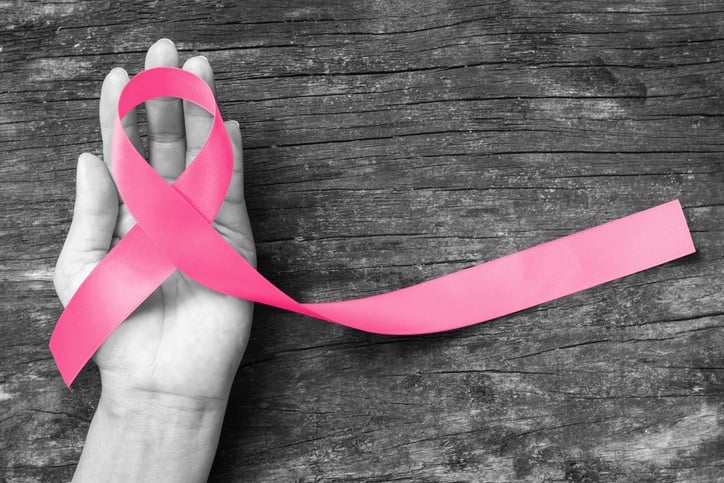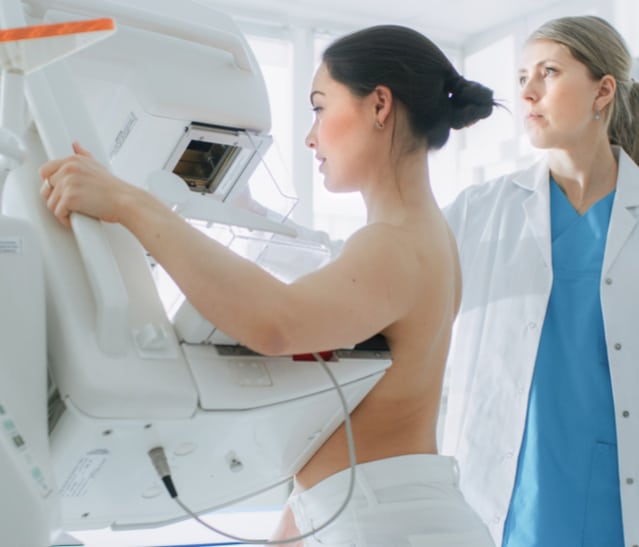Mammograms are an important tool for the early diagnosis of breast cancer, which is key to successful treatment. At Craig Ranch OB/GYN, we perform mammograms in our offices, so our patients don’t have to make a second appointment elsewhere.
Over the past few years, there have been some questions about mammograms, so here is what you need to know about this important diagnostic tool.

What Is A Mammogram?
A mammogram is an X-ray image of the breasts used as a screening tool for breast cancer. During a mammogram, the patient’s breasts are compressed between two firm surfaces to spread out the tissue. The X-ray energy then creates black and white images of your breasts that we can instantly see on-screen in our McKinney offices. We use Solis Radiology to help with the interpretation of our mammograms.
What Are Mammograms Used For?
Mammography can be used either as a screening tool or for diagnostic purposes if a breast lump has been found:
- Screening — These are mammograms done on patients who have no signs or symptoms of breast abnormalities. They are done to detect cancer as early as possible.
- Diagnostic — If a patient has changes in her breast, such as a new lump, pain, unusual skin appearance, nipple thickening, or nipple discharge, a mammogram is used to evaluate the situation. These mammograms involve additional images compared to a screening mammogram.

What Age Should I Start Having Mammograms?
There really isn’t a consensus or an ideal age for a woman to start screening for breast cancer. Risk factors such as family history play a role. The team at Craig Ranch will discuss these factors with you and together we’ll decide when and how often you should have a mammogram.
These are general guidelines:
- Women with an average risk of breast cancer — Most women begin having mammograms at age 40 and have them every one to two years after that. There is some variance between professional groups about this timing.
- Women with a high risk of breast cancer — Women who are at high risk for developing breast cancer could be advised to begin screening prior to their 40th birthday. If you have a family history or have had precancerous breast lesions previously, this would probably merit earlier mammogram screenings.
Do Mammograms Hurt?
When your breast is gradually pressed against the platform by a clear plastic plate, the goal is to spread out the breast tissue. This pressure doesn’t damage the breast, but it can be uncomfortable, even painful. If this is the case, please tell your Craig Ranch technician and we’ll try and adjust your position to make it more comfortable. The compression is necessary, however, to even out the thickness of the breasts and to decrease blurring from movement. It also minimizes the amount of radiation that is necessary to create the images.
How Often Should A Woman Get A Mammogram?
As discussed above under the “what age” question, there isn’t consensus about whether annual or every other year mammograms are the way to go. Current guidelines from the U.S. Department of Health and Human Services and the American College of Radiology recommend screening mammograms every year for women, beginning at age 40.
We will discuss timelines with you. There is a slight risk of cancer from the exposure to radiation in a mammogram, but the benefit of an accurate diagnosis far outweighs this risk.

When Will I Get The Results From My Mammogram?
Once the radiologist analyzes your images, we will receive a signed report on the findings. Because we have mammogram equipment in our Craig Ranch OB/GYN offices, we can usually get your results and contact you with the findings either in the same day as your gynecological appointment, or the next day.
Risks Of Mammograms
Mammograms do present some limitations and risks:
- You are exposed to some radiation — The doses are very low, and the benefits outweigh the risk here.
- Accuracy — Some factors, such as breast density and your age, can result in false-negative or false-positive mammogram readings.
- Reading younger mammograms can be more difficult — Because the breasts of younger women are more glandular and contain more ligaments than the breasts of older women, this dense tissue can obscure signs of cancer. With age, breast tissue becomes fattier, making it easier to detect changes on mammograms.
- Screening mammograms cannot detect all cancers — Mammograms can miss roughly 1 in 5 cancers in women.
- Mammograms can lead to additional testing — When a mammogram is read and thought to be abnormal, additional testing will be required, such as an ultrasound or a biopsy. Most of these abnormal findings are not cancer, but the extra testing still must be done to be sure.
Hear Why People Are Choosing Craig Ranch OB/GYN
“I love this place! They are never late to take you back and appointments are quick and easy. They are super knowledgable and the office is spotless. The doctor is so welcoming and listens to any concerns you may have.”
“This office is awesome! All the Doctors are so caring and really take their time with their patients. They addressed all my concerns and I did not feel rushed at all. The office is beautiful and so clean. The office staff was very helpful and knowledgeable. I could tell they all enjoy their jobs. I highly recommend Craig Ranch OB/GYN.”
What Happens If A Lump Or Other Abnormality Is Found?
If the radiologist finds areas of concern on your mammogram, the next step is usually to opt for additional testing. These additional tests seek to better understand the area or areas of concern. Additional mammograms, known as compression or magnification views, are one additional test. Ultrasound imaging is another. A biopsy may be merited to take a sample of the breast tissue in question for laboratory testing.

How Do I Perform A Breast Self-Exam?
Breast self-exams are important to spot early signs of changes in your breasts. There is a visual and tactile component to these tests.
Visual inspection
Stand in front of the mirror and do these steps:
- Face forward and look for puckering, dimpling, or changes in size, shape, or symmetry.
- Check to see if your nipples are turned inward.
- Press your hands down on your hips and then inspect your breasts.
- Raise your arms overhead with your palms pressed together and inspect your breasts.
- Lift your breasts to see if the ridges along the bottom are symmetrical.
Hand examination
You can perform a manual examination when you are either lying down or in the shower. Lying down has the advantage of having the breast tissue spread out and flatten, making it thinner and easier to feel. These are the steps to follow:
- Don’t use your fingertips, but the pads where your fingerprints are. Use your three middle fingers.
- Apply different amounts of pressure to feel the different depths of your breasts. Light for the tissue closest to the surface, medium to feel a little deeper, and firm for tissue closest to the chest and ribs.
- Be methodical. You can visualize a clock on your breasts and work section by section.
How Effective Are Breast Self-Exams?
A breast self-exam is not a substitute for a breast exam by the team at Craig Ranch OB/GYN or a screening mammogram. These exams are important for women to become familiar with the normal look and feel of their breasts, but they are only a supplemental cancer screening. They are not meant to replace mammograms or doctor visits.
More Testimonials
“Dr. Derrick is so friendly, welcoming and makes you feel so comfortable. You can talk to her about anything and she doesn’t judge. She knows how to work through your issues without making you feel bad in any way. I would recommend this dr’s office to anyone & have many times. They are a wonderful blessing to all who go there!”
“I highly recommend Dr. Sara Robert! She is an excellent doctor and skilled surgeon. More importantly, she has a really great personality which put me at ease. I actually look forward to my appointments and that’s a first with any doctor for me!”

Schedule Your Consultation
To schedule your consultation at our McKinney, TX office, call 214.544.6600. The providers at Craig Ranch OB/GYN are proud to serve patients in McKinney and surrounding areas of Texas.

